This first table shows the SE’s Watts/10 Delta Temp numbers in a quick glance chart format.
Using the data compiled from the SE thermal testing I have compiled the following tables in an attempt to show other ways of how its performance varies against itself at the flow rates and fan speeds tested. Effectively these show percentage gains relative to a reference point. It’s an interesting way to show gains/losses while changing a variable.
First let’s focus on 1300 RPM as our reference and see how much gain or loss in performance we get by changing fan speed.
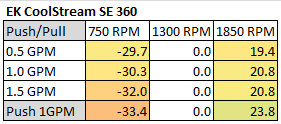 Neutral tones here indicate the SE is tuned for best performance somewhere around this 1300rpm fan speed range. In the next plot we focus on changing the flow rate with 1.0 GPM as the base line.
Neutral tones here indicate the SE is tuned for best performance somewhere around this 1300rpm fan speed range. In the next plot we focus on changing the flow rate with 1.0 GPM as the base line.
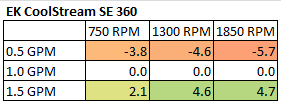 With only slight percentage changes when changing the flow rate we conclude that flow rate is not a determining factor for performance on the SE.
With only slight percentage changes when changing the flow rate we conclude that flow rate is not a determining factor for performance on the SE.
How about we combine both flow rate and fan speed as reference points and have a look at 0.5 GPM & 750 RPM as the reference point.
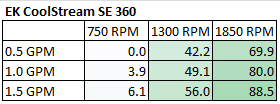 This confirms what we speculated for the 1300 table, as here we see a big boost from 750rpm to 1300rpm, and a smaller increase from 1300rpm to 1850rpm.
This confirms what we speculated for the 1300 table, as here we see a big boost from 750rpm to 1300rpm, and a smaller increase from 1300rpm to 1850rpm.
Lastly, we change the reference and choose our center 1300 RPM and 1.0 GPM as our reference point to show both effects concurrently:
So from the data above we can get a very good idea of how the SE360 radiator performs relative to itself. But there is a large selection of 360mm radiator models to choose from, released from numerous manufacturers. So, we need to start comparing performance between them.
Push Only Data vs Competition
Let’s focus on the Push Only results for now and come back to the Push/Pull data later. While for Push/Pull we tested three flow rates, the Push Only testing was conducted only at 1GPM in order to save time. For a comparison vs thicker radiators make sure to check out the 2015 Rad Round Up which compares 27+ radiators including the SE.
Let’s start with 750 RPM and see how it compares to the competition:
The SE places 2nd to last in the low speed Push Only rankings with performance ~18.5% behind the winner. Not a surprising result given it has the thinnest core (but only just to the XSPC EX model)
How does the SE do at 1300 rpm? Pretty poor again actually.
Now in last place the SE is ~20% behind the winner for 1300rpm.
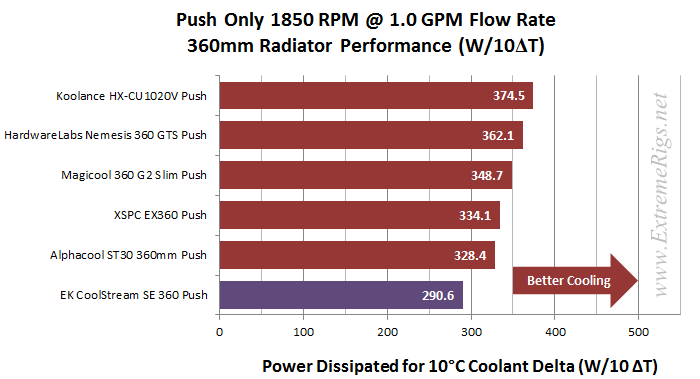
At 1850 Push Only the SE again places last of the slim rads tested, still ~22.5% behind the best performing slim rad.
So the SE was a poor performer in Push Only (as expected given the core structure). The fan speeds made little difference to its comparisons against the competition. At this stage we are hoping that to save some grace the SE will compare better with a Push/Pull fan assembly, even though this is probably not what the intended use for a slim rad actually is for most users.
Let’s find out how it fared…..
Push/Pull Data vs. Competition
Let’s now look at the Push/Pull results and see how the SE 360 compares. For Push/Pull we have averaged the results from the 3 flow rates at which we tested.
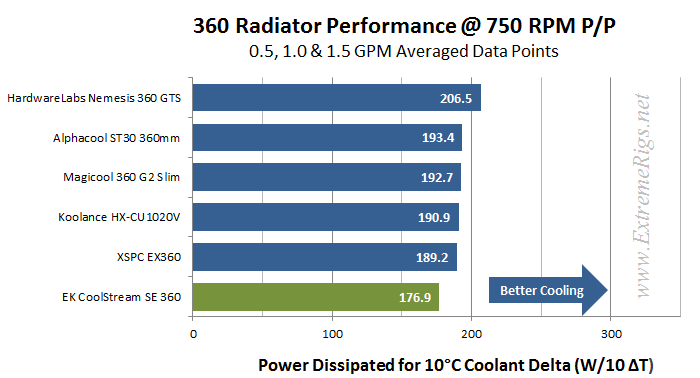 The SE 360 continues its losing streak collecting another wooden spoon. The result is closer with ~15% gap between the SE and the winner, but low speed results are usually very tightly grouped, so 15% is a lot in this instance.
The SE 360 continues its losing streak collecting another wooden spoon. The result is closer with ~15% gap between the SE and the winner, but low speed results are usually very tightly grouped, so 15% is a lot in this instance.
Let’s move to the 1300 rpm then:
While the other slim rads catch up to the leader, the SE falls further behind, now ~22.5% behind.
So the averaged 1850 rpm results:
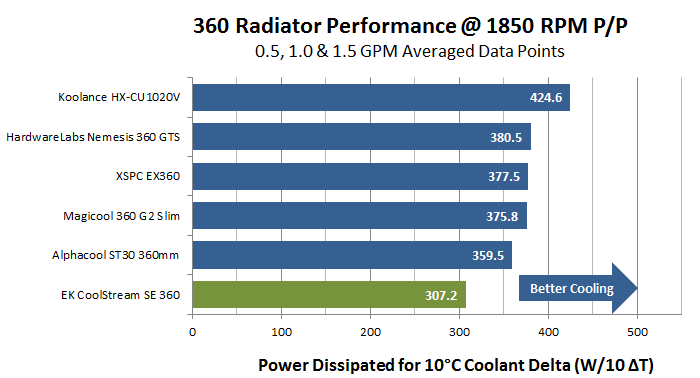
At 1850 Push/Pull the SE 360…well you get the picture as the same trend continues.
So the SE 360 placed last in all 5 of the categories. Pretty terrible performance and I find it amazing that EK have come up with a design and core that performs so poorly in every scenario especially when you realize that a similar design was used in the XE and that performs at the top of the charts for thicker radiators..
Let’s also combine the Push Only and Push/Pull results at the 1.0 GPM flow rate into one plot for each fan speed tested. These plots show just how well the best slim radiators performed against the competition, while clearly showing the SE’s lack of performance.
Again the 750 rpm first:
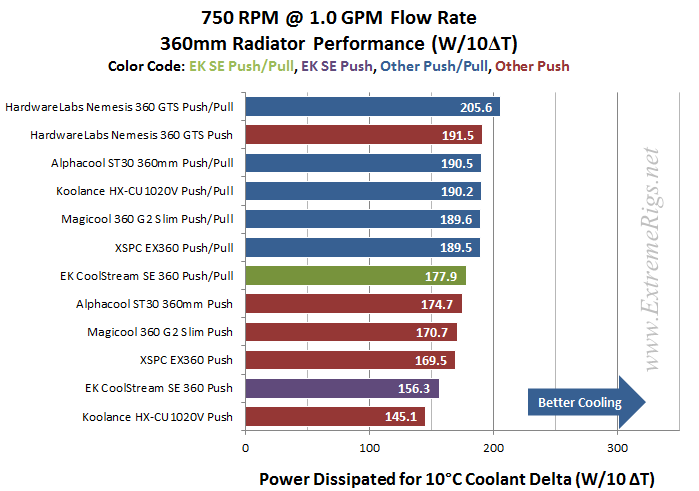
The SE just holds manages to keep afloat here with its Push/Pull results at least beating 4 other rads Push Only results.
At 1300 rpm and 1850 rpm the same cannot be said, it’s almost embarrassing to have to publish the data as the SE’s Push/Pull results are worse then the other slim rad’s Push Only results.
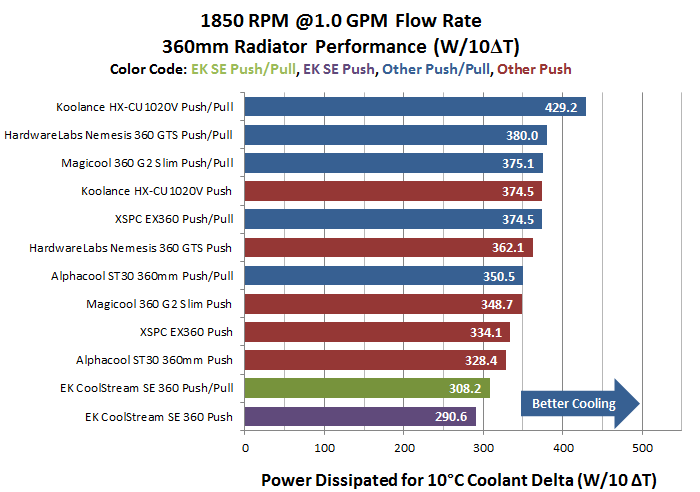
From all of test results we created “Average Performance Factor” charts for both Push and Push/Pull and then a combined plot called the “Master Performance Factor”. The radiator with the best cooling ability (W/10ΔT) at each gpm/rpm combo was awarded a score of 100, and each other radiators W/10ΔT result was scored as percentage of the top performer.
This way of looking at the comparison takes away any advantages that a radiator may have at higher or lower fan speeds and looks at an overall average. While this appears fair it does tend to favor those radiators that are all-rounders and those radiators which do very well at high RPM. Most users should be more focused on their specific use case. Check in the Round Up for performance comparisons at every gpm/rpm combo for even more details and cross comparison results.
Here is the SE360’s Push/Pull percentage scores at each data point that thermal tests were conducted at and additionally the 1.0 gpm Push Only percentages relative to the winner at each fan speed.
This is not a very flattering results table to say the least. Stating the obvious, it is by far the worst set of results of the test group.
Then we started averaging the percentage scores at each flow rate giving us the Averaged Performance Factors of each radiator.
Firstly – the Push Only APF:
We know it performed terribly in all types of fan assemblies, but the data must be published.
Finally we created the Master Performance Factor which is calculated from the averaged results of all the thermal tests, Push and Push/Pull at all flow rates and all fan speeds.
In the Master Performance Factor comparisons the SE 360 finishes in last place, no surprises here. If anything we can say it was consistent, placing last in nearly every thermal test we conducted. Not only was it last but it was last by a considerable margin.
I really didn’t expect the SE to perform so badly across the board, but it did. The SE’s core does appear tuned best for medium fan speeds, however that was still poor in relation to the other slim rads.
Next up – Summary!








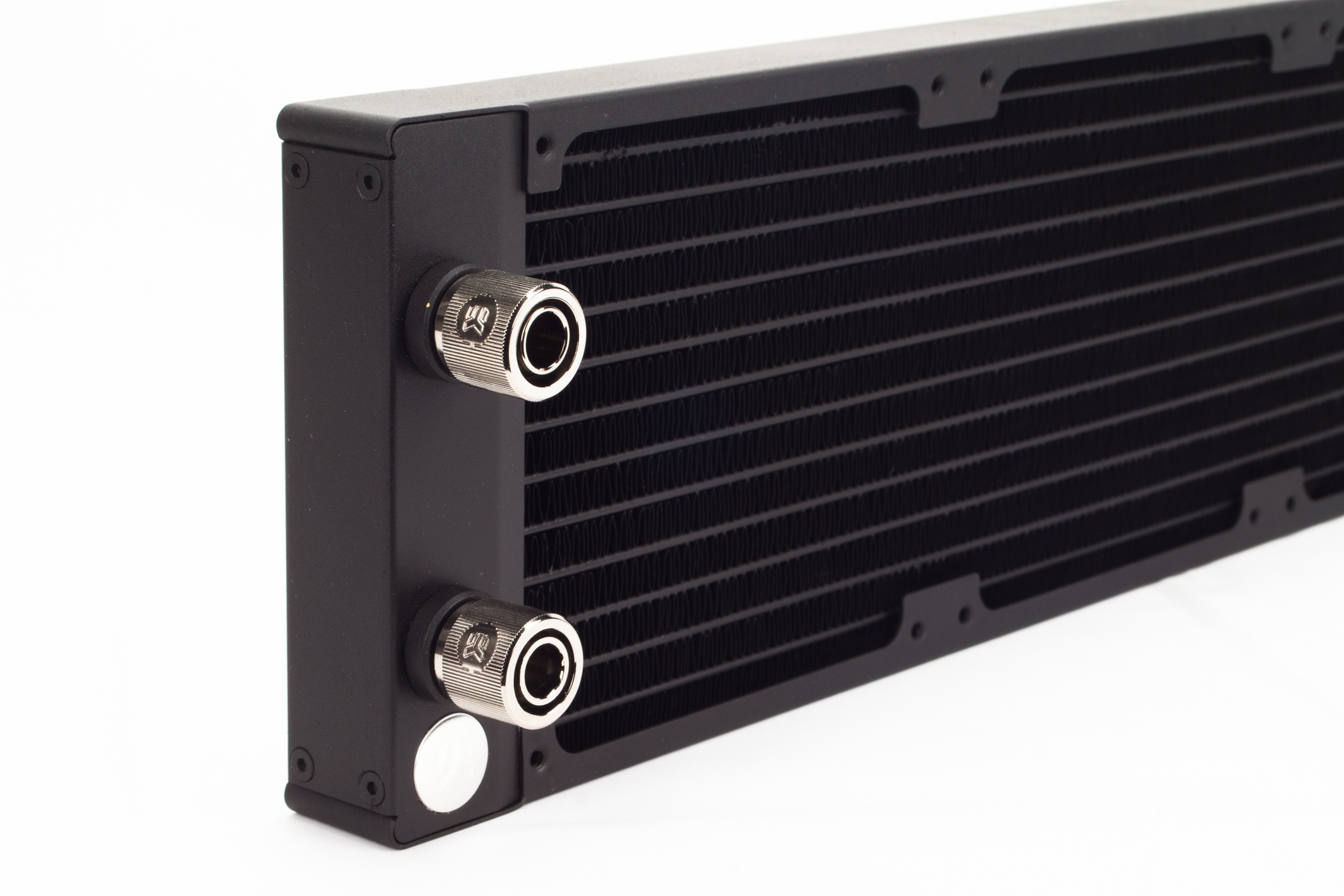
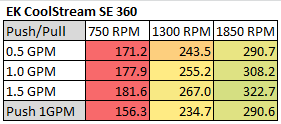
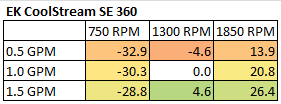
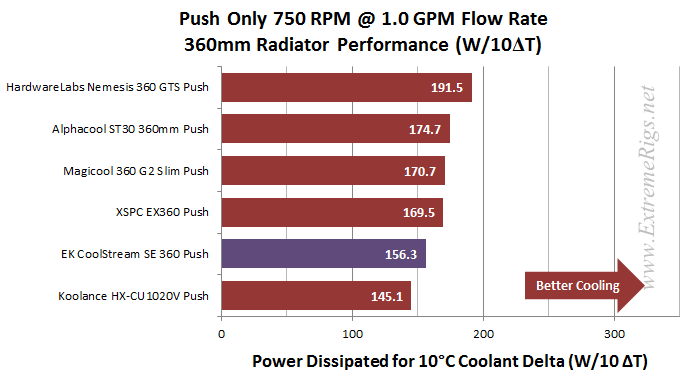
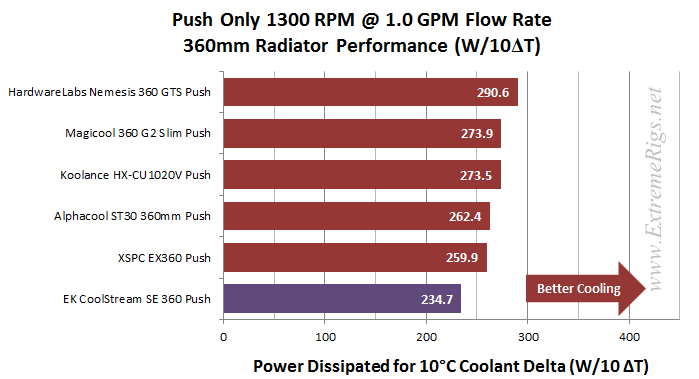
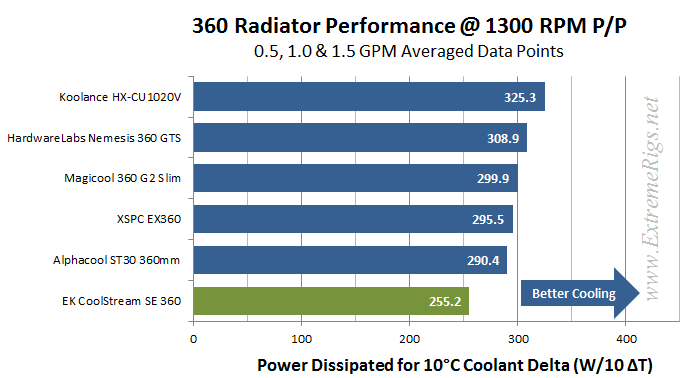
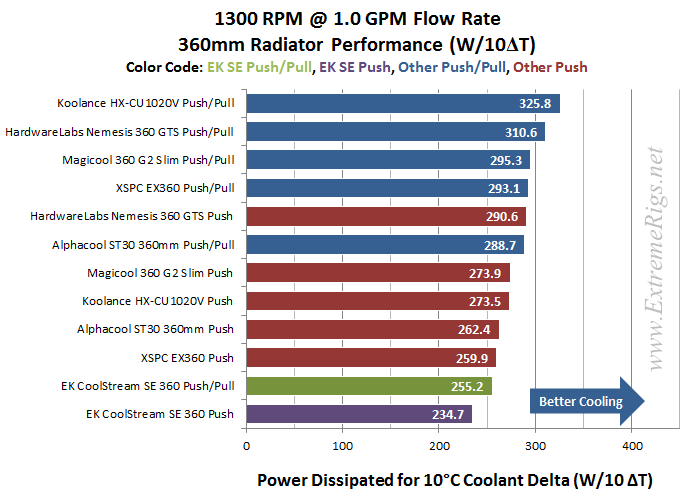
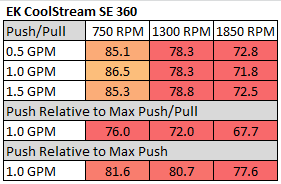
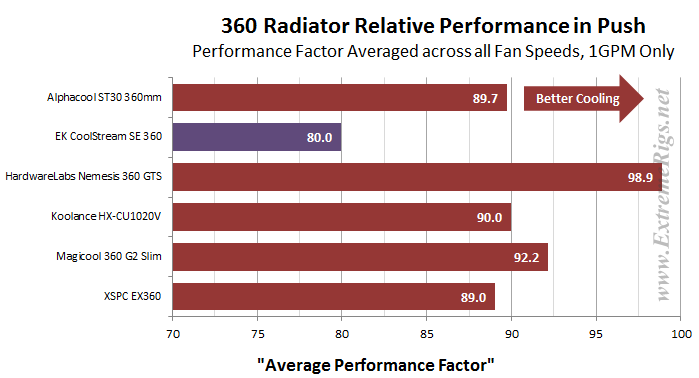
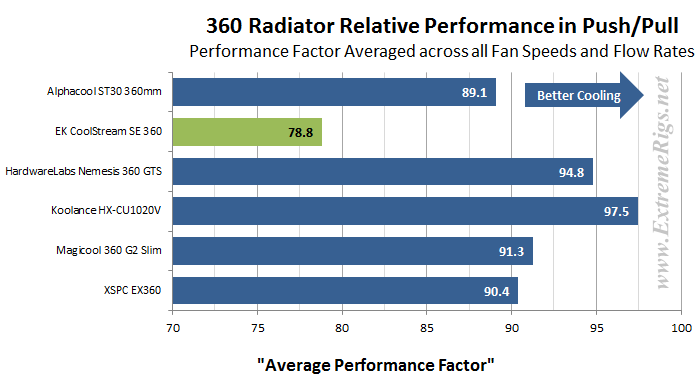
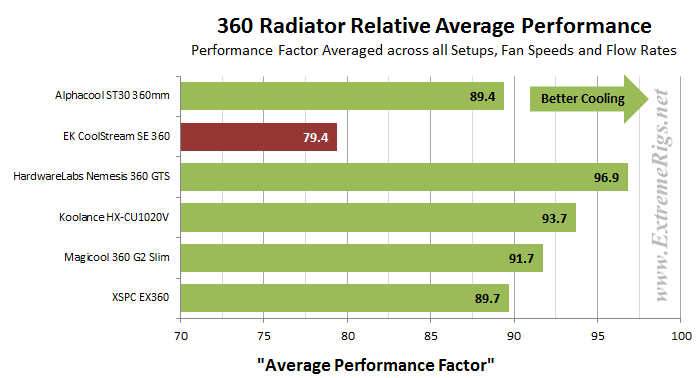



[…] EK CoolStream SE 360mm Radiator Review […]
Thank you for doing this terrific review. It is very useful in the context of the earlier radiator round up you did. Really appreciate the methodology. I am currently choosing slim radiators for a new build; although the Hardware Labs Nemesis GTS series are almost impossible to find in Europe, I think that I will pay up for shipping and customs charges to get a pair sent to me in the UK.
(I’ve tried Hardware Labs importers / retailers in the UK, France, Germany, Italy and the Netherlands: all have terrible stock levels, usually only stocking a few old / superseded models and nowhere like the full range. When I have contacted the UK and Dutch importers to special order two Nemesis GTS they either tried to sell me different radiators that I did not want but which they had in stock, or replied saying we can’t order anything from Hardware Labs for you, or didn’t even bother to reply).
Another great review FF, thanks.
Some surprising results for the SE! Man, I yell ya, I am giving up trying to make predictions. I was concerned that the move to 1.5mms tubes would mean high restriction but it’s really quite reasonable. Quite disappointing thermal results that is hard to understand considering how well it’s thicker brother did.
I guess it just shows how valuable your work is because we just can’t make any assumptions.
Hey Jak,
Yeah this one was pretty low across the board.
I Just finished another 360mm slim rad, it was weaker than the SE with low speed fans, especially in Push Only, but turned out to dominate in the high speed fans because it has a very high FPI count.
I used to try and make predictions, but but doing so can be dangerous, as the predictions can slip easily into assumptions, which in turn tend to make you look for patterns in the data which may or may not end up being there. At this stage you’re questioning the validity of the results, and do a retest, only to get the same results.
Better for sanity’s sake to accurately set the test parameters, and then trust the data that is logged.
Comments are closed.